TOYOTA YARIS 2016 Owners Manual
Manufacturer: TOYOTA, Model Year: 2016, Model line: YARIS, Model: TOYOTA YARIS 2016Pages: 592, PDF Size: 10.44 MB
Page 541 of 592
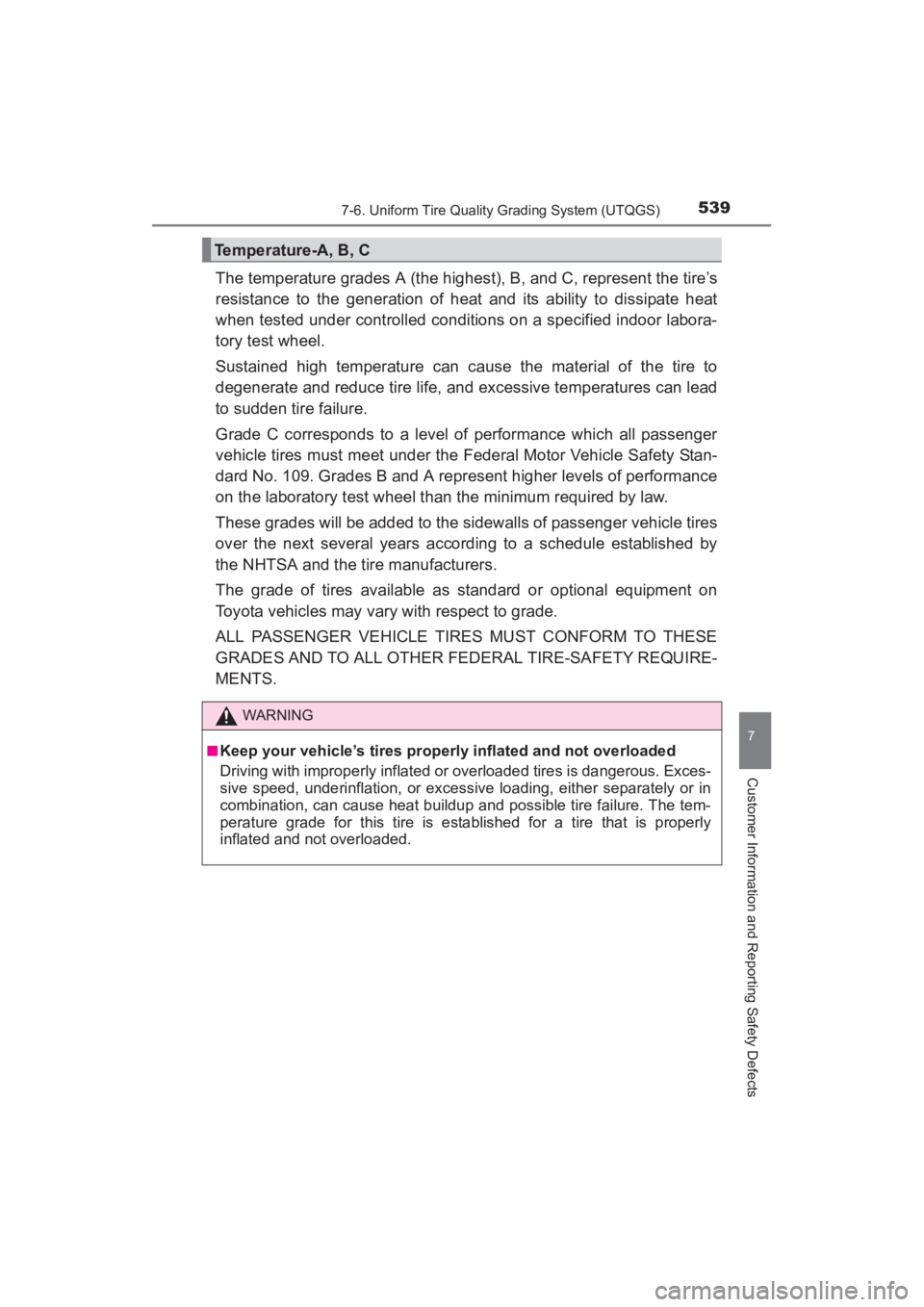
YARIS_SEDAN_OM_OM99M18z_(U)
5397-6. Uniform Tire Quality Grading System (UTQGS)
7
Customer Information and Reporting Safety Defects
The temperature grades A (the highest), B, and C, represent the tire’s
resistance to the generation of heat and its ability to dissipate heat
when tested under controlled conditions on a specified indoor labora-
tory test wheel.
Sustained high temperature can cause the material of the tire to
degenerate and reduce tire life, and excessive temperatures can lead
to sudden tire failure.
Grade C corresponds to a level of performance which all passenger
vehicle tires must meet under the Federal Motor Vehicle Safety Stan-
dard No. 109. Grades B and A represent higher levels of performance
on the laboratory test wheel than the minimum required by law.
These grades will be added to the sidewalls of passenger vehicle tires
over the next several years according to a schedule established by
the NHTSA and the tire manufacturers.
The grade of tires available as standard or optional equipment on
Toyota vehicles may vary with respect to grade.
ALL PASSENGER VEHICLE TIRES MUST CONFORM TO THESE
GRADES AND TO ALL OTHER FEDERAL TIRE-SAFETY REQUIRE-
MENTS.
Temperature-A, B, C
WARNING
■Keep your vehicle’s tires properly inflated and not overloaded
Driving with improperly inflated or overloaded tires is dangerous. Exces-
sive speed, underinflation, or excessive loading, either separately or in
combination, can cause heat buildup and possible tire failure. The tem-
perature grade for this tire is established for a tire that is properly
inflated and not overloaded.
YARIS_SEDAN_OM_OM99M18z_(U).book Page 539 Monday, June 1, 2015 9:22 PM
Page 542 of 592
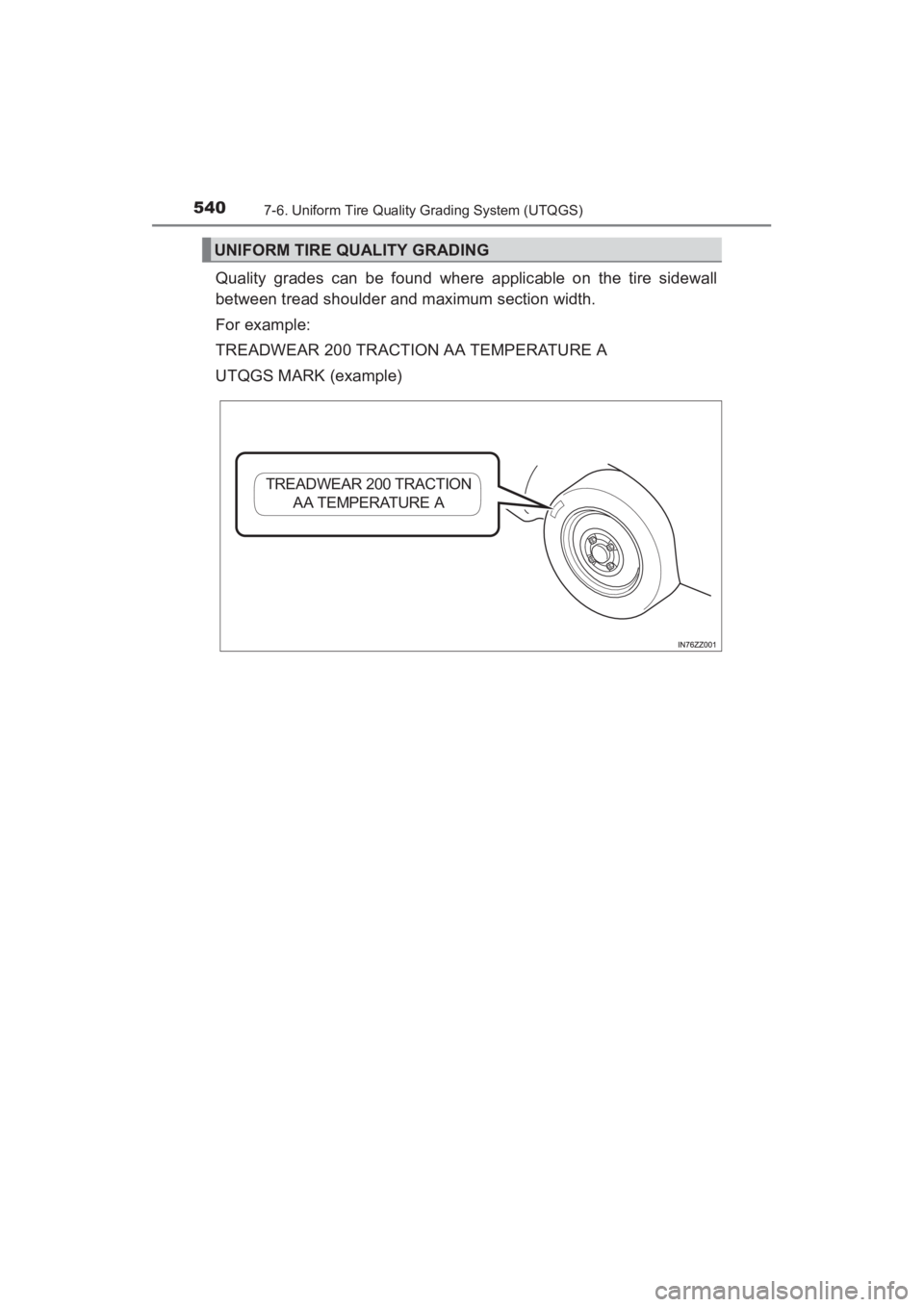
540
YARIS_SEDAN_OM_OM99M18z_(U)
7-6. Uniform Tire Quality Grading System (UTQGS)
Quality grades can be found where applicable on the tire sidewall
between tread shoulder and maximum section width.
For example:
TREADWEAR 200 TRACTION AA TEMPERATURE A
UTQGS MARK (example)
UNIFORM TIRE QUALITY GRADING
TREADWEAR 200 TRACTION AA TEMPERATURE A
YARIS_SEDAN_OM_OM99M18z_(U).book Page 540 Monday, June 1, 2015 9:22 PM
Page 543 of 592
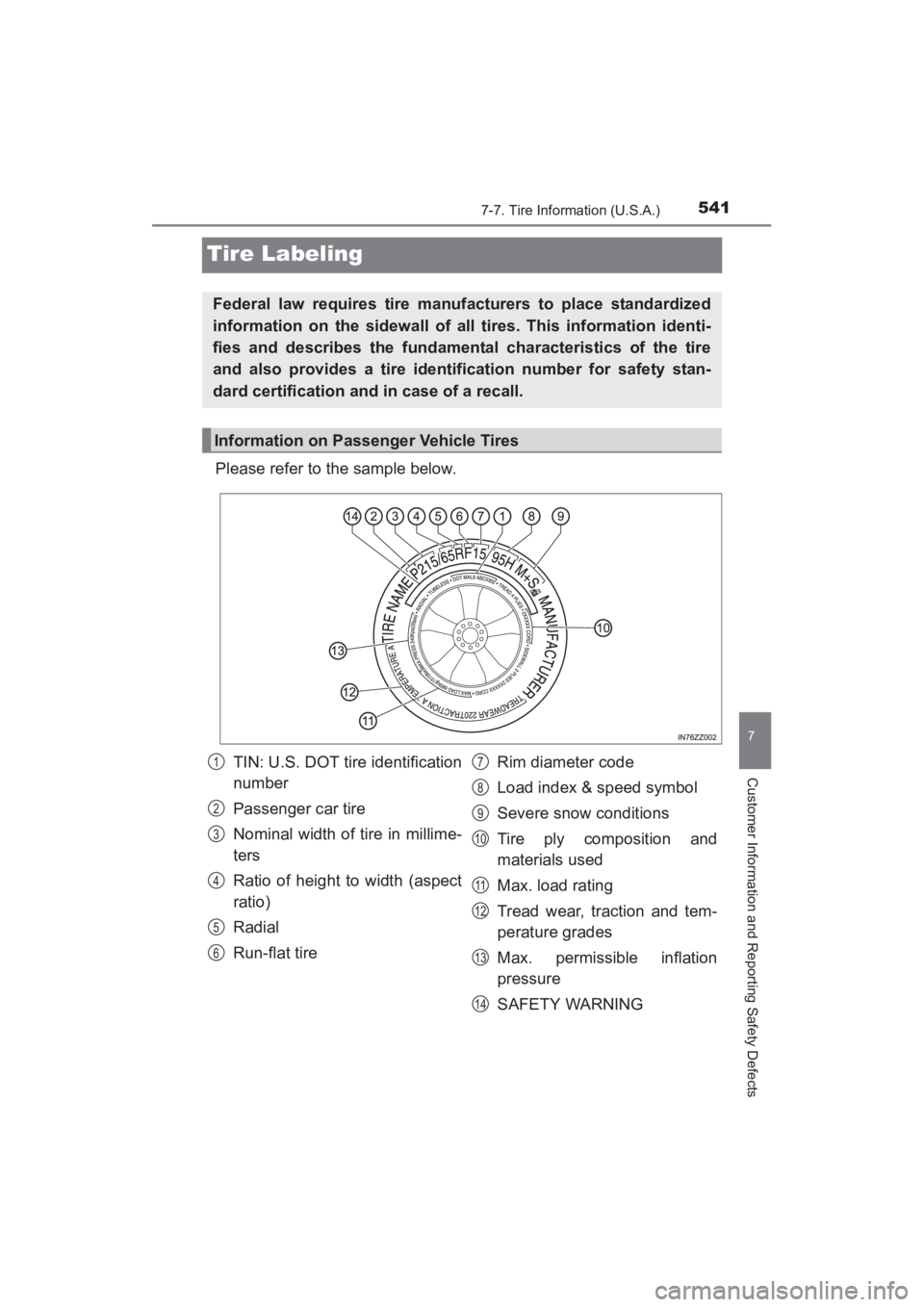
541
YARIS_SEDAN_OM_OM99M18z_(U)
7-7. Tire Information (U.S.A.)
7
Customer Information and Reporting Safety Defects
Tire Labeling
Please refer to the sample below.
Federal law requires tire manufacturers to place standardized
information on the sidewall of all tires. This information identi-
fies and describes the fundamental characteristics of the tire
and also provides a tire identification number for safety stan-
dard certification and in case of a recall.
Information on Passenger Vehicle Tires
TIN: U.S. DOT tire identification
number
Passenger car tire
Nominal width of tire in millime-
ters
Ratio of height to width (aspect
ratio)
Radial
Run-flat tireRim diameter code
Load index & speed symbol
Severe snow conditions
Tire ply composition and
materials used
Max. load rating
Tread wear, traction and tem-
perature grades
Max. permissible inflation
pressure
SAFETY WARNING1
2
3
4
5
6
7
8
9
10
11
12
13
14
YARIS_SEDAN_OM_OM99M18z_(U).book Page 541 Monday, June 1, 2015 9:22 PM
Page 544 of 592
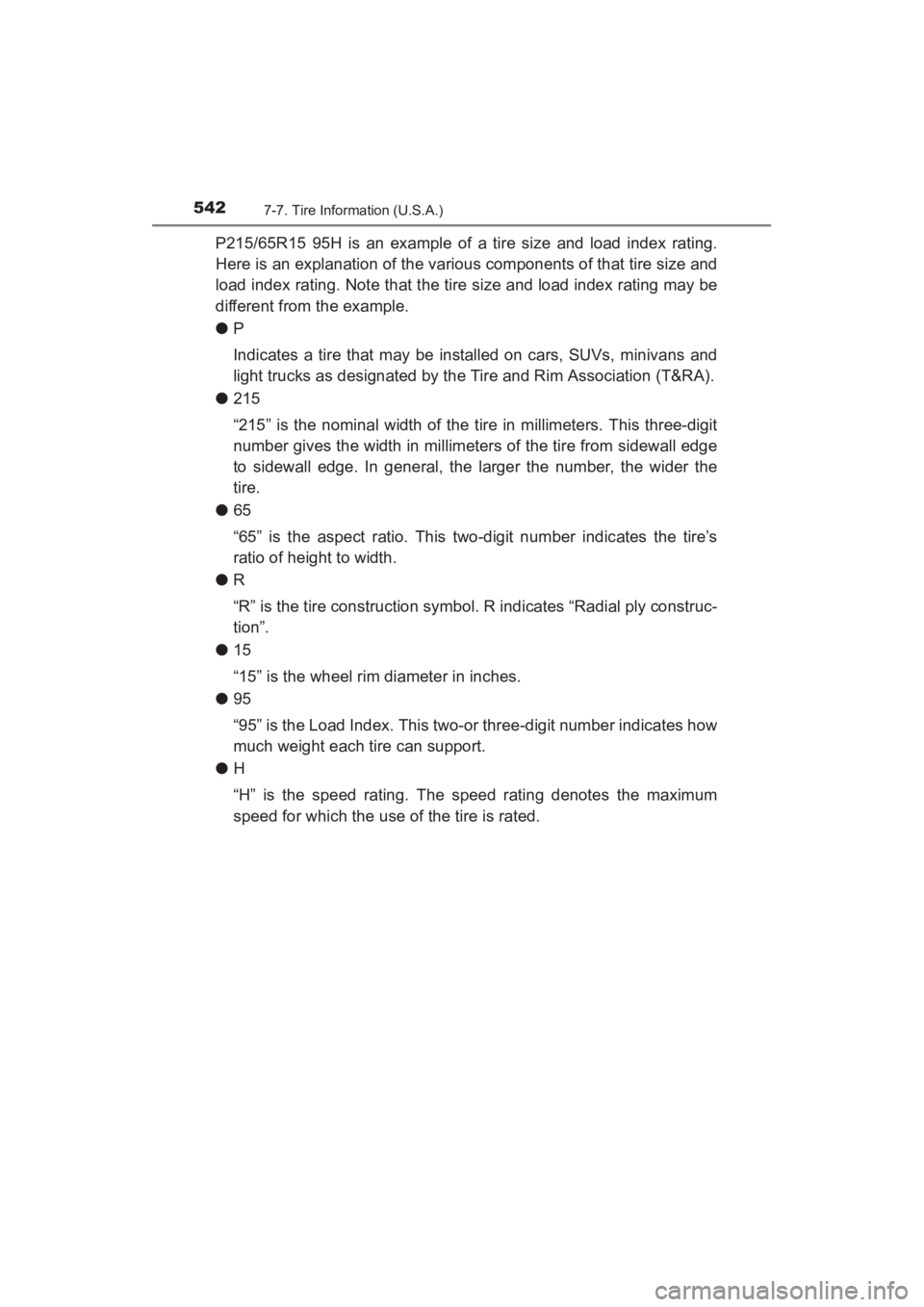
542
YARIS_SEDAN_OM_OM99M18z_(U)
7-7. Tire Information (U.S.A.)
P215/65R15 95H is an example of a tire size and load index rating.
Here is an explanation of the various components of that tire size and
load index rating. Note that the tire size and load index rating may be
different from the example.
●P
Indicates a tire that may be installed on cars, SUVs, minivans and
light trucks as designated by the Tire and Rim Association (T&RA).
● 215
“215” is the nominal width of the tire in millimeters. This three-digit
number gives the width in millimeters of the tire from sidewall edge
to sidewall edge. In general, the larger the number, the wider the
tire.
● 65
“65” is the aspect ratio. This two-digit number indicates the tire’s
ratio of height to width.
● R
“R” is the tire construction symbol. R indicates “Radial ply construc-
tion”.
● 15
“15” is the wheel rim diameter in inches.
● 95
“95” is the Load Index. This two-or three-digit number indicates how
much weight each tire can support.
● H
“H” is the speed rating. The speed rating denotes the maximum
speed for which the use of the tire is rated.
YARIS_SEDAN_OM_OM99M18z_(U).book Page 542 Monday, June 1, 2015 9:22 PM
Page 545 of 592
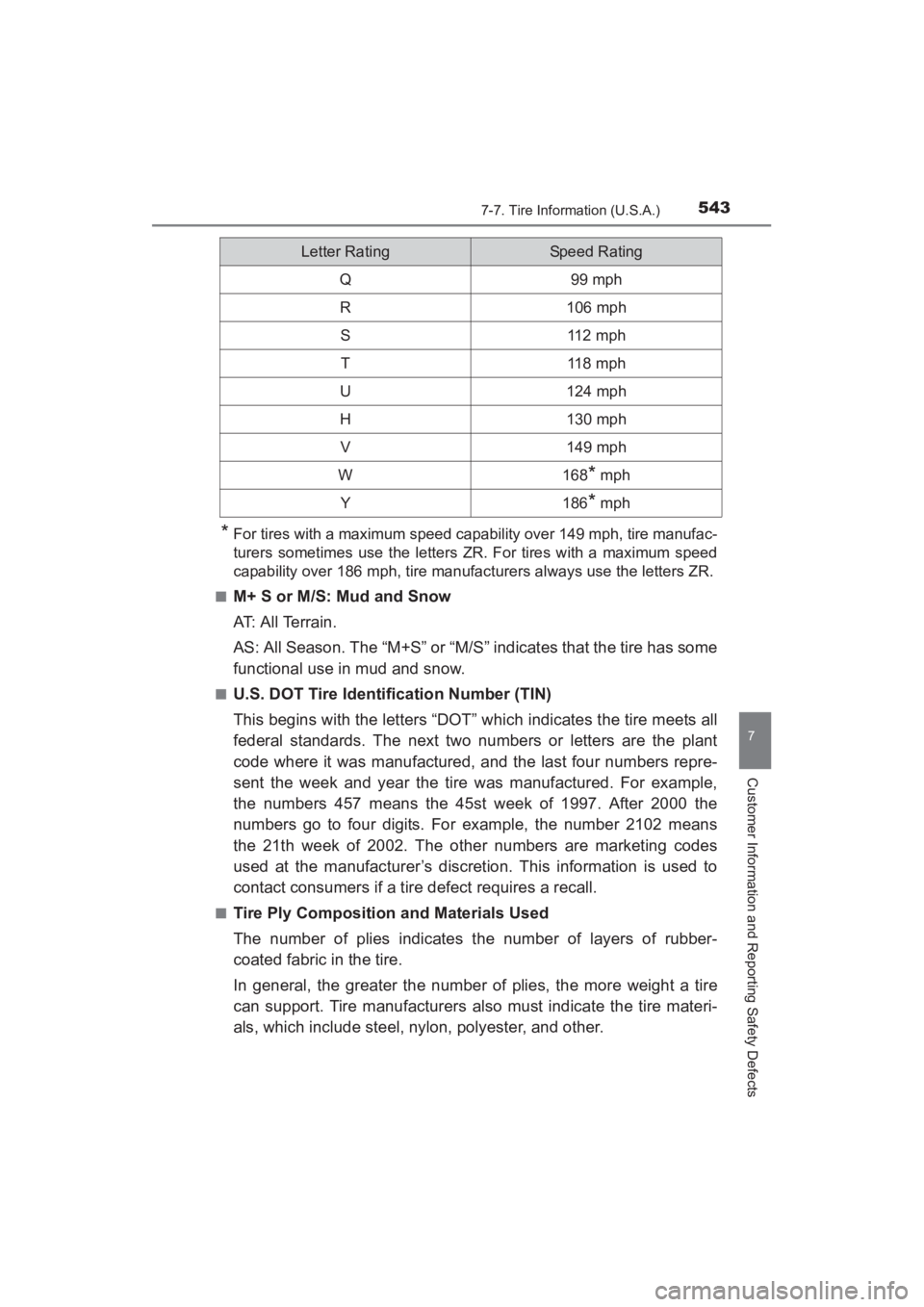
YARIS_SEDAN_OM_OM99M18z_(U)
5437-7. Tire Information (U.S.A.)
7
Customer Information and Reporting Safety Defects
*For tires with a maximum speed capability over 149 mph, tire manufac-
turers sometimes use the letters ZR. For tires with a maximum speed
capability over 186 mph, tire manufacturers always use the letters ZR.
■M+ S or M/S: Mud and Snow
AT: All Terrain.
AS: All Season. The “M+S” or “M/S” indicates that the tire has some
functional use in mud and snow.
■U.S. DOT Tire Identification Number (TIN)
This begins with the letters “DOT” which indicates the tire meets all
federal standards. The next two numbers or letters are the plant
code where it was manufactured, and the last four numbers repre-
sent the week and year the tire was manufactured. For example,
the numbers 457 means the 45st week of 1997. After 2000 the
numbers go to four digits. For example, the number 2102 means
the 21th week of 2002. The other numbers are marketing codes
used at the manufacturer’s discretion. This information is used to
contact consumers if a tire defect requires a recall.
■Tire Ply Composition and Materials Used
The number of plies indicates the number of layers of rubber-
coated fabric in the tire.
In general, the greater the number of plies, the more weight a tire
can support. Tire manufacturers also must indicate the tire materi-
als, which include steel, nylon, polyester, and other.
Letter RatingSpeed Rating
Q99 mph
R106 mph
S11 2 m p h
T11 8 m p h
U124 mph
H130 mph
V149 mph
W168* mph
Y186* mph
YARIS_SEDAN_OM_OM99M18z_(U).book Page 543 Monday, June 1, 2015 9:22 PM
Page 546 of 592
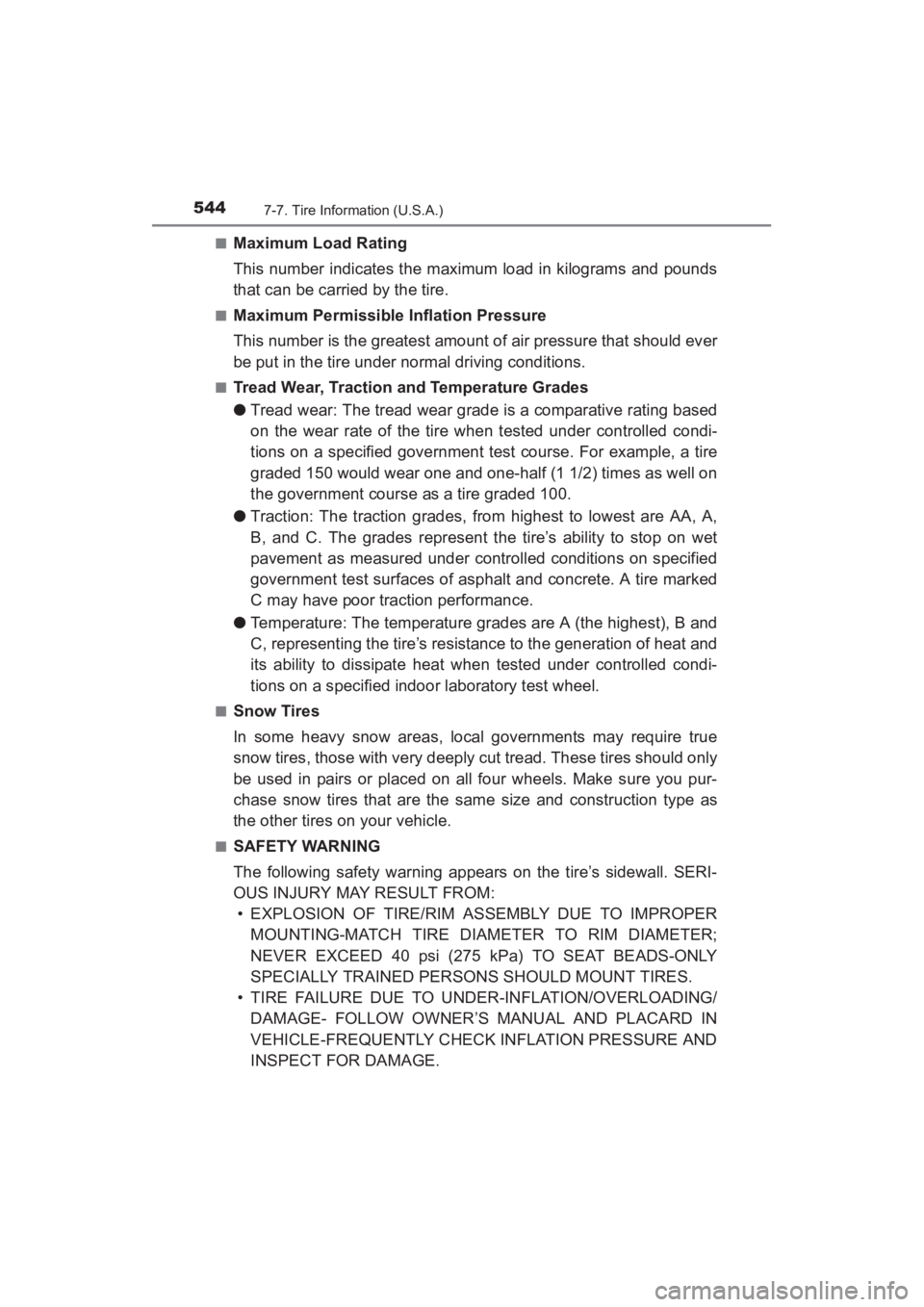
544
YARIS_SEDAN_OM_OM99M18z_(U)
7-7. Tire Information (U.S.A.)
■Maximum Load Rating
This number indicates the maximum load in kilograms and pounds
that can be carried by the tire.
■Maximum Permissible Inflation Pressure
This number is the greatest amount of air pressure that should ever
be put in the tire under normal driving conditions.
■Tread Wear, Traction and Temperature Grades
●Tread wear: The tread wear grade is a comparative rating based
on the wear rate of the tire when tested under controlled condi-
tions on a specified government test course. For example, a tire
graded 150 would wear one and one-half (1 1/2) times as well on
the government course as a tire graded 100.
● Traction: The traction grades, from highest to lowest are AA, A,
B, and C. The grades represent the tire’s ability to stop on wet
pavement as measured under controlled conditions on specified
government test surfaces of asphalt and concrete. A tire marked
C may have poor traction performance.
● Temperature: The temperature grades are A (the highest), B and
C, representing the tire’s resistance to the generation of heat and
its ability to dissipate heat when tested under controlled condi-
tions on a specified indoor laboratory test wheel.
■Snow Tires
In some heavy snow areas, local governments may require true
snow tires, those with very deeply cut tread. These tires should only
be used in pairs or placed on all four wheels. Make sure you pur-
chase snow tires that are the same size and construction type as
the other tires on your vehicle.
■SAFETY WARNING
The following safety warning appears on the tire’s sidewall. SERI-
OUS INJURY MAY RESULT FROM:
• EXPLOSION OF TIRE/RIM ASSEMBLY DUE TO IMPROPER MOUNTING-MATCH TIRE DIAMETER TO RIM DIAMETER;
NEVER EXCEED 40 psi (275 kPa) TO SEAT BEADS-ONLY
SPECIALLY TRAINED PERSONS SHOULD MOUNT TIRES.
• TIRE FAILURE DUE TO UNDER-INFLATION/OVERLOADING/ DAMAGE- FOLLOW OWNER’S MANUAL AND PLACARD IN
VEHICLE-FREQUENTLY CHECK INFLATION PRESSURE AND
INSPECT FOR DAMAGE.
YARIS_SEDAN_OM_OM99M18z_(U).book Page 544 Monday, June 1, 2015 9:22 PM
Page 547 of 592
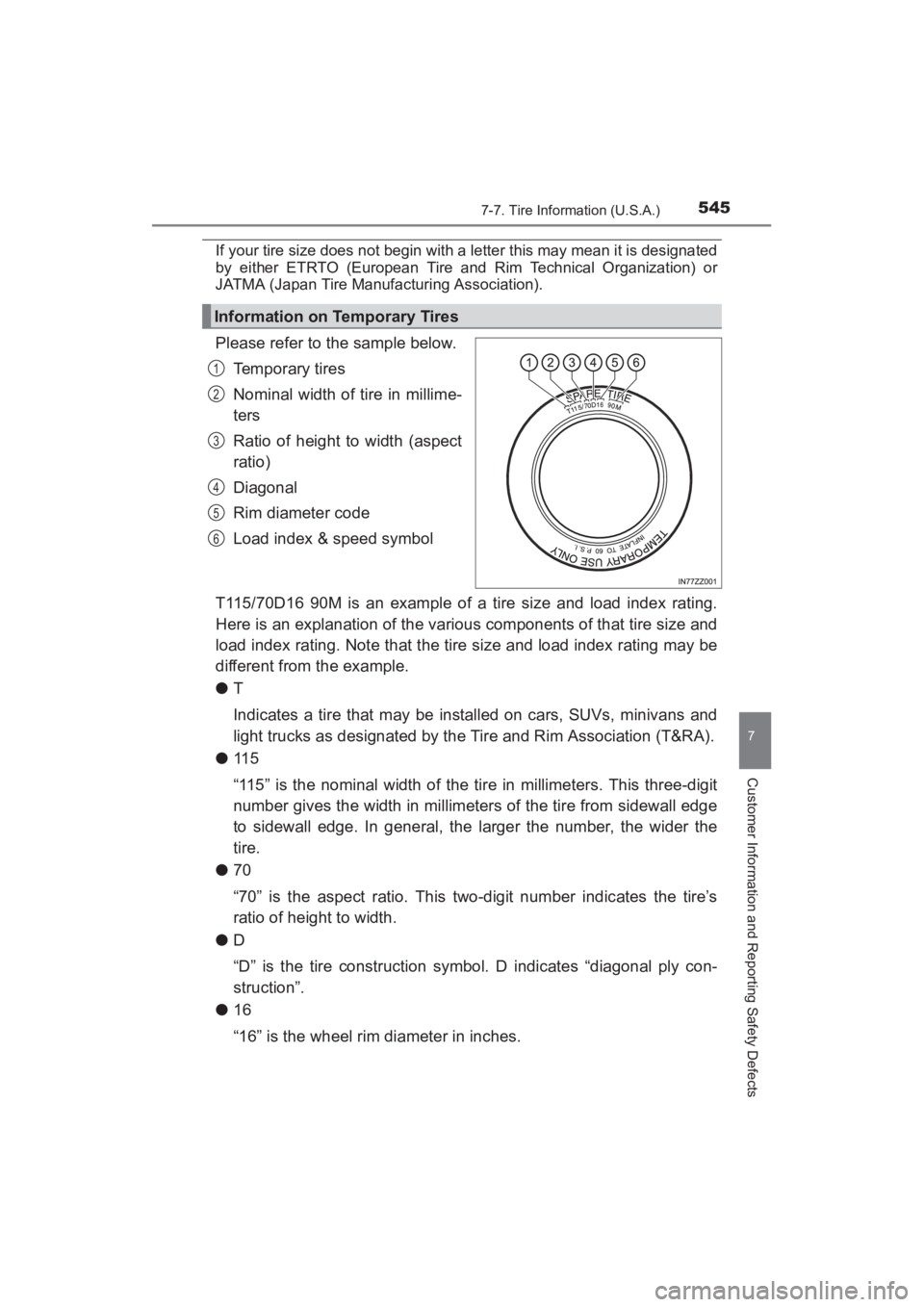
YARIS_SEDAN_OM_OM99M18z_(U)
5457-7. Tire Information (U.S.A.)
7
Customer Information and Reporting Safety Defects
If your tire size does not begin with a letter this may mean it is designated
by either ETRTO (European Tire and Rim Technical Organization) or
JATMA (Japan Tire Manufacturing Association).
Please refer to the sample below.Temporary tires
Nominal width of tire in millime-
ters
Ratio of height to width (aspect
ratio)
Diagonal
Rim diameter code
Load index & speed symbol
T115/70D16 90M is an example of a tire size and load index rating.
Here is an explanation of the various components of that tire size and
load index rating. Note that the tire size and load index rating may be
different from the example.
● T
Indicates a tire that may be installed on cars, SUVs, minivans and
light trucks as designated by the Tire and Rim Association (T&RA).
● 11 5
“115” is the nominal width of the tire in millimeters. This three-digit
number gives the width in millimeters of the tire from sidewall edge
to sidewall edge. In general, the larger the number, the wider the
tire.
● 70
“70” is the aspect ratio. This two-digit number indicates the tire’s
ratio of height to width.
● D
“D” is the tire construction symbol. D indicates “diagonal ply con-
struction”.
● 16
“16” is the wheel rim diameter in inches.
Information on Temporary Tires
1
2
3
4
5
6
YARIS_SEDAN_OM_OM99M18z_(U).book Page 545 Monday, June 1, 2015 9:22 PM
Page 548 of 592
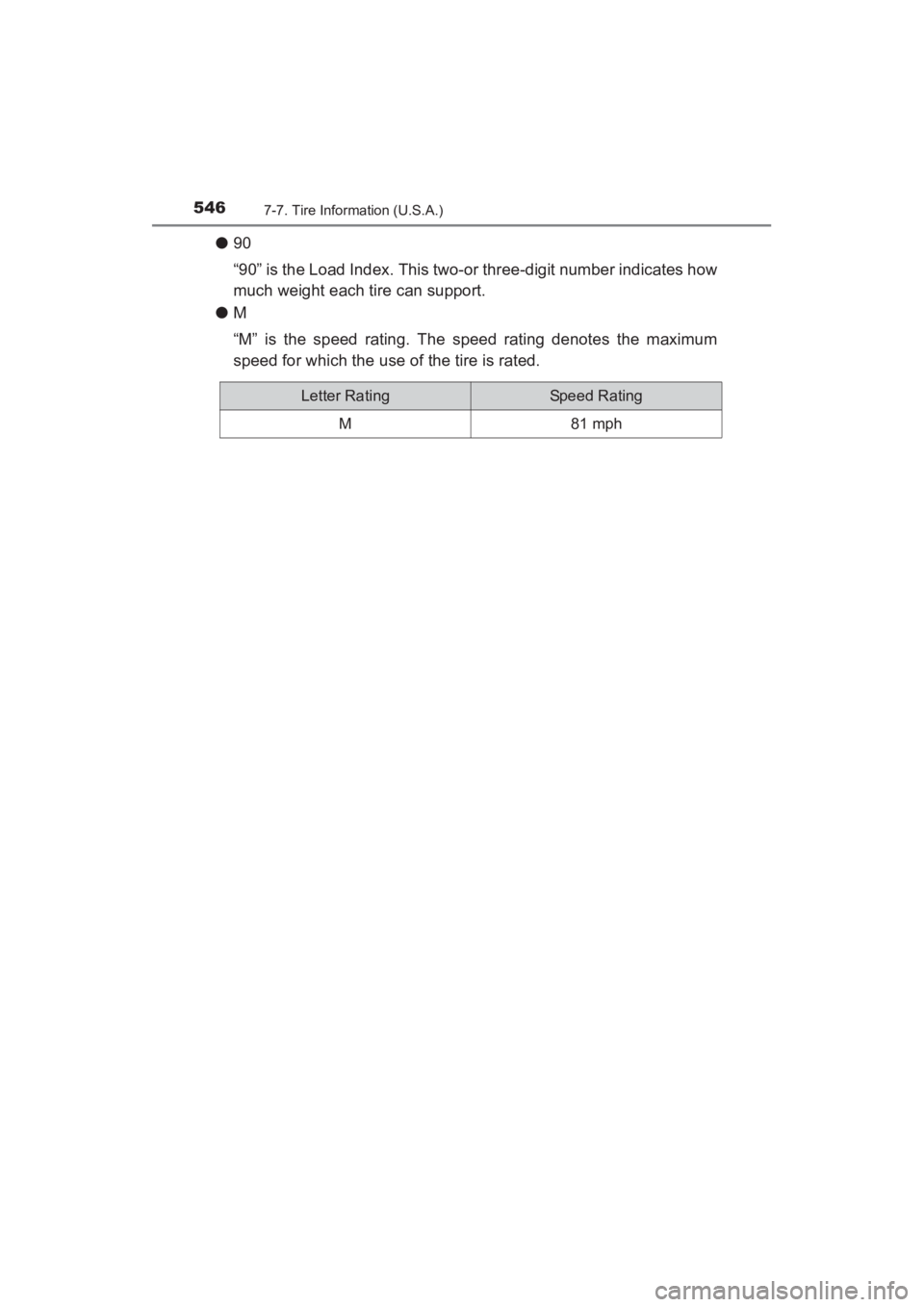
546
YARIS_SEDAN_OM_OM99M18z_(U)
7-7. Tire Information (U.S.A.)
●90
“90” is the Load Index. This two-or three-digit number indicates how
much weight each tire can support.
● M
“M” is the speed rating. The speed rating denotes the maximum
speed for which the use of the tire is rated.
Letter RatingSpeed Rating
M81 mph
YARIS_SEDAN_OM_OM99M18z_(U).book Page 546 Monday, June 1, 2015 9:22 PM
Page 549 of 592
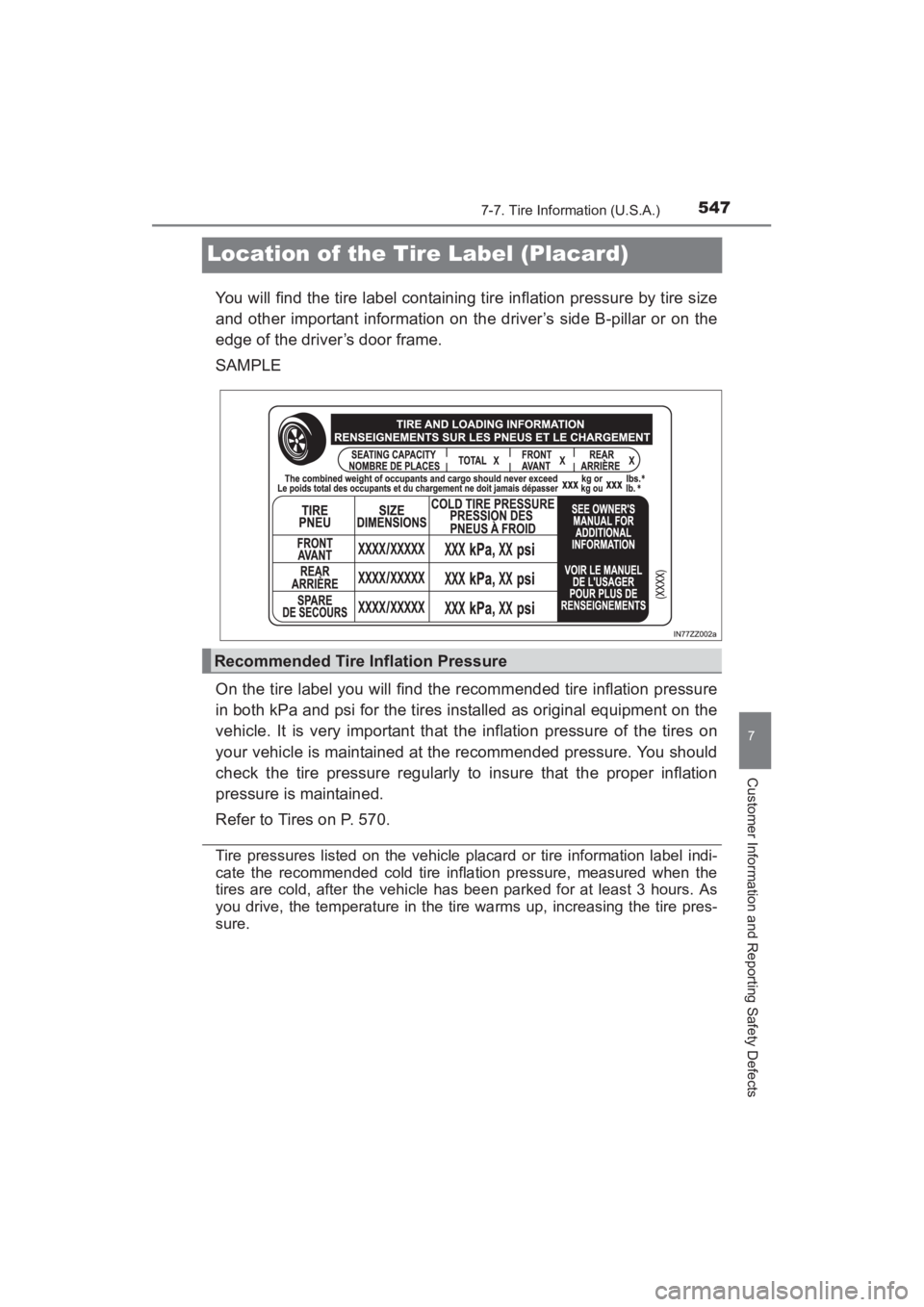
547
YARIS_SEDAN_OM_OM99M18z_(U)
7-7. Tire Information (U.S.A.)
7
Customer Information and Reporting Safety Defects
Location of the Tire Label (Placard)
You will find the tire label containing tire inflation pressure by tire size
and other important information on the driver’s side B-pillar or on the
edge of the driver’s door frame.
SAMPLE
On the tire label you will find the recommended tire inflation pressure
in both kPa and psi for the tires installed as original equipment on the
vehicle. It is very important that the inflation pressure of the tires on
your vehicle is maintained at the recommended pressure. You should
check the tire pressure regularly to insure that the proper inflation
pressure is maintained.
Refer to Tires on P. 570.
Tire pressures listed on the vehicle placard or tire information label indi-
cate the recommended cold tire inflation pressure, measured when the
tires are cold, after the vehicle has been parked for at least 3 hours. As
you drive, the temperature in the tire warms up, increasing the tire pres-
sure.
Recommended Tire Inflation Pressure
YARIS_SEDAN_OM_OM99M18z_(U).book Page 547 Monday, June 1, 2015 9:22 PM
Page 550 of 592
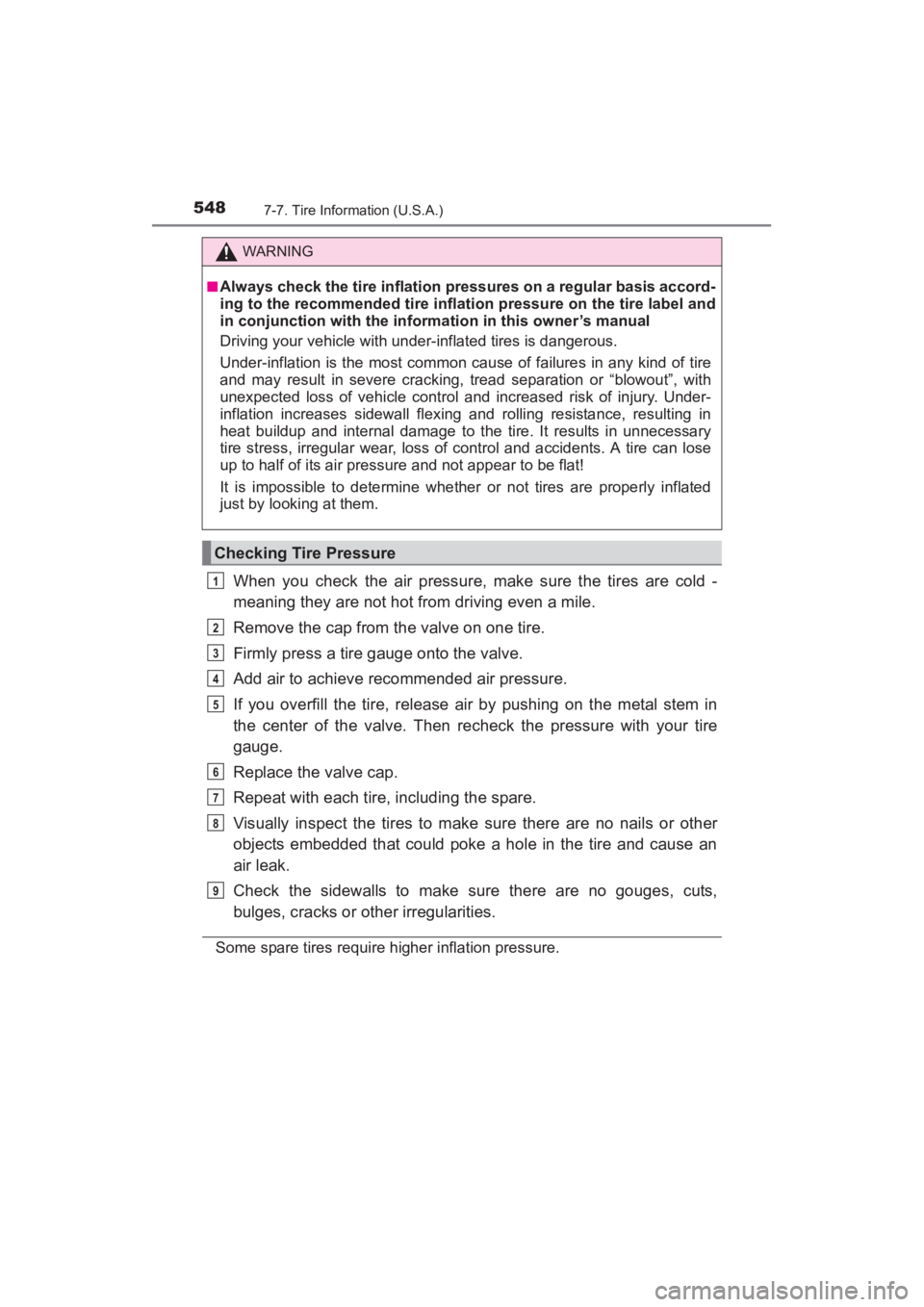
548
YARIS_SEDAN_OM_OM99M18z_(U)
7-7. Tire Information (U.S.A.)
When you check the air pressure, make sure the tires are cold -
meaning they are not hot from driving even a mile.
Remove the cap from the valve on one tire.
Firmly press a tire gauge onto the valve.
Add air to achieve recommended air pressure.
If you overfill the tire, release air by pushing on the metal stem in
the center of the valve. Then recheck the pressure with your tire
gauge.
Replace the valve cap.
Repeat with each tire, including the spare.
Visually inspect the tires to make sure there are no nails or other
objects embedded that could poke a hole in the tire and cause an
air leak.
Check the sidewalls to make sure there are no gouges, cuts,
bulges, cracks or other irregularities.
Some spare tires require higher inflation pressure.
WARNING
■Always check the tire inflation pressures on a regular basis accord-
ing to the recommended tire inflation pressure on the tire label and
in conjunction with the information in this owner’s manual
Driving your vehicle with under-inflated tires is dangerous.
Under-inflation is the most common cause of failures in any kind of tire
and may result in severe cracking, tread separation or “blowout”, with
unexpected loss of vehicle control and increased risk of injury. Under-
inflation increases sidewall flexing and rolling resistance, resulting in
heat buildup and internal damage to the tire. It results in unnecessary
tire stress, irregular wear, loss of control and accidents. A tire can lose
up to half of its air pressure and not appear to be flat!
It is impossible to determine whether or not tires are properly inflated
just by looking at them.
Checking Tire Pressure
1
2
3
4
5
6
7
8
9
YARIS_SEDAN_OM_OM99M18z_(U).book Page 548 Monday, June 1, 2015 9:22 PM